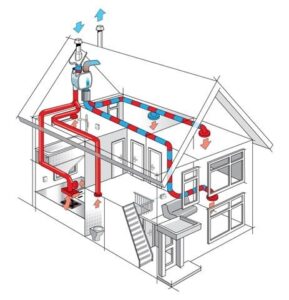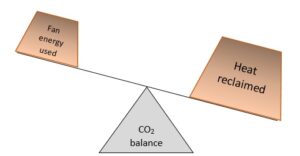Mechanical Ventilation Systems with Heat Recovery (MVHR) are becoming much more commonplace in new builds and they can play an important part in energy efficient design.
 They can also negate overheating problems, improve indoor air quality and can remove issues associated with increasingly air tight dwellings. So what should you look out for when specifying an MVHR system?
They can also negate overheating problems, improve indoor air quality and can remove issues associated with increasingly air tight dwellings. So what should you look out for when specifying an MVHR system?
How Does MVHR Work?
MVHR systems use fans and ducts to extract warm stale air from the bathrooms and kitchen, and draw this through a heat exchanger in order to warm incoming fresh air, which is fed into the living space and bedrooms. This system allows a dwelling to be very air tight, thus containing heat within the building, while also ensuring adequate indoor air quality.
What to look out for
For such a system to be effective, certain good practices should be followed. For a system to be worthwhile, the heat reclaimed should far outweigh the energy used to power the fans.
With this in mind, a rule of thumb is to achieve the following:
- SFP (Specific Fan Power) < 1.0 W/L/s – This relates to the electrical efficiency of the fans. The lower, the better with some systems getting as low as 0.5 W/L/s
- Heat Exchange efficiency > 85% – This indicates how much of the heat will be transferred from the outgoing air to the incoming air
- Air tightness of the dwelling ≤ 3 m3/hm2 (@50Pa) – An airtight building will prevent heat being lost through natural ventilation and ensure the system runs efficiently

Of course, the MVHR unit itself is just one component of the system and the real world performance will depend on the design, sizing, installation and maintenance of the whole system.
Installing an MVHR unit can easily turn into a costly and ineffective experiment if care is not taken. For an efficient and effective system make sure to:
- Match the system with the size and layout of the dwelling
- Ensure effective ducting. Ideally, go for rigid ducting and limit the number of bends
- Position the unit and ducting within the thermal envelope (not in the loft!)
- Locate the intake terminal so as to avoid sources of external pollution
- Consider means of limiting noise such as fitting silencers
- Ensure correct design, installation and commissioning of the system
- Ensure accessibility of the unit (for servicing & repair) and the controls / indicators
- Make sure the end users know how to operate the system effectively
- Change the filter at 6 month intervals
See you next time!
